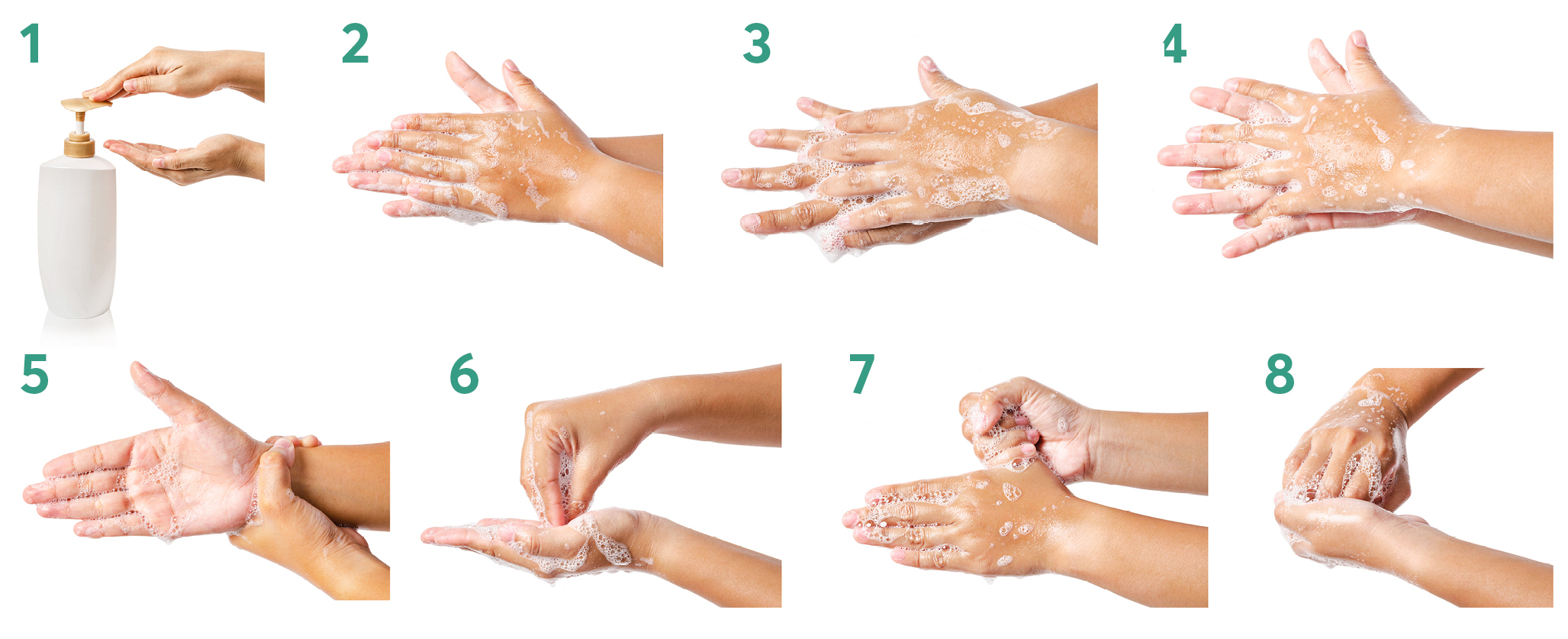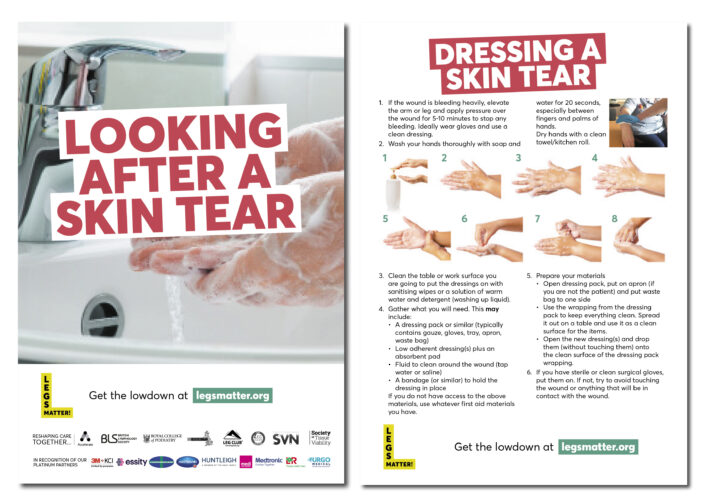Looking after a wound or skin tear
- If the wound is bleeding heavily, elevate the arm or leg and apply pressure over the wound for 5-10 minutes to stop any bleeding. Ideally wear gloves and use a clean dressing.
- Wash your hands thoroughly with soap and water for 20 seconds, especially between fingers and palms of hands. Dry hands with a clean towel/kitchen roll.

Clean the table or work surface you are going to put the dressings on with sanitising wipes or a solution of warm water and detergent (washing up liquid).
Gather what you will need. This may include:
• A dressing pack or similar (typically contains gauze, gloves, tray, apron, waste bag)
• Low adherent dressing(s) plus an absorbent pad
• Fluid to clean around the wound (tap water or saline)
• A bandage (or similar) to hold the dressing in place
If you do not have access to the above materials, use whatever first aid materials you have.
Prepare your materials
• Open dressing pack, put on apron (if you are not the patient) and put waste bag to one side
• Use the wrapping from the dressing pack to keep everything clean. Spread it out on a table and use it as a clean surface for the items.
• Open the new dressing(s) and drop them (without touching them) onto the clean surface of the dressing pack wrapping.
If you have sterile or clean surgical gloves, put them on. If not, try to avoid touching the wound or anything that will be in contact with the wound.
Dressing a skin tear
- Gently pour some fluid over the wound and check that any debris has been removed. If any skin is rolled back, moisten your gloved finger with the fluid and carefully realign any loose skin back in place taking care not to stretch or tear the skin. If blood has collected under the skin flap, gently wash this away, if possible. Dry the skin by gently patting with dry gauze or paper towel, taking care to not dislodge the skin flap.
- Still wearing the gloves (if you have any) open the dressing and make sure that the central pad is big enough to cover all the broken skin.
- Before applying the dressing draw an arrow on the dressing showing which way would be best to remove the dressing so the flap will not move. The arrow should start from the most secure part of the skin flap (the edge that is still attached). Add the date you apply the dressing.
- Apply the dressing over the wound, following the instructions that came in the dressing pack. Apply from the attached edge first to help to prevent the flap lifting or rolling up and gently press the edges down. If the dressing has a backing paper, remove the backing paper.
- If the dressing is not adhesive, use as little adhesive tape as possible and/or hold the dressing in place with a light bandage or tubular bandage
- If you need dressings request these from your healthcare professional. Dressings can stay in place up to 7 days unless the dressing becomes loose, leaks, or becomes uncomfortable (or a healthcare professional has advised otherwise).
- Skin tears on the lower leg will heal better with some support such as from a flight sock or light compression. If used, choose the right size (your health care professional or pharmacist can help advise) and apply carefully following the instructions.
How to change the dressing
Dressings can stay in place up to 7 days unless the dressing becomes loose, or leaks, or becomes uncomfortable (or you have been advised otherwise).
Prepare to change the dressing by following instructions 2-6 above.
- Carefully remove the old dressing by lifting from the indicated corner to prevent the skin flap from moving.
- If the dressing is stuck, soak with water or saline and wait for the dressing to loosen – be patient and avoid pulling as this will be painful and will damage the wound.
- If the dressing is adhesive or has an adhesive border, lift the indicated corner and gently peel in the direction of the arrow keeping close to the skin. Take your time and go slowly.
If the wound is still open, apply another dressing as described above. If the wound is dry or scabbed, there is no need to apply another dressing unless the wound needs protecting. Simple unscented moisturiser can be helpful.
Place the dirty dressing in the waste bag and wash your hands.
Clear up, put sealed waste bag in bin and wash your hands. (The waste bag can go in the usual rubbish collection unless you have been advised otherwise.)
Ongoing care
- Monitor for signs of infection or other problems:
- More wound leakage than usual
- More pain than usual
- Increasing redness around the wound
- An unusual smell
- Wound is getting bigger
- Feeling generally unwell
Contact your health care professional or NHS 111 if you are worried.
Based on a document produced by the National Wound Care Strategy Programme. Accessed from their website on 14 April 2020.
Download this guide
One of the documents from our series to help you self-care at home. A 4 page document giving a step by step approach.

Tell us what you think
If there’s anything you want to ask us or tell us, whether it’s a suggestion about our website, a complaint, or a compliment, drop us a line at
support@legsmatter.org









